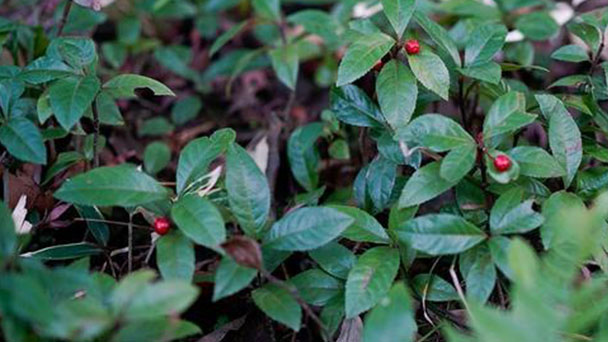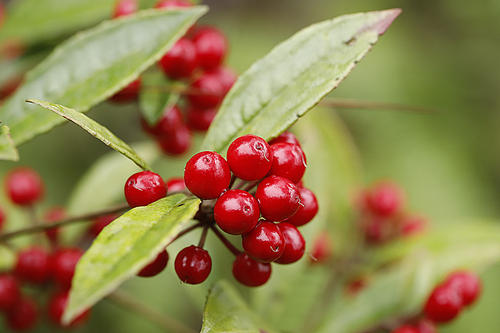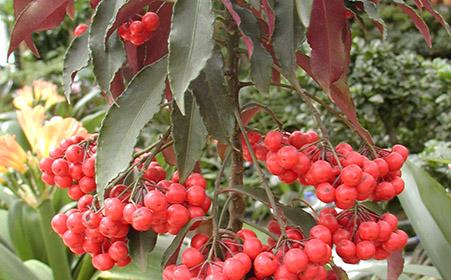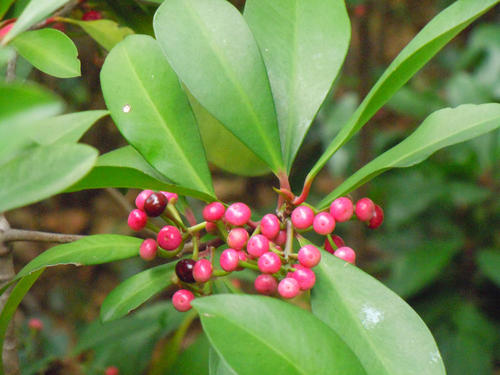Ardisia Japonica (Japanese Ardisia) profile
Written by Maggie
Oct 15 2021

Ardisia Japonica, also known as Japanese ardisia, is a small shrub or subshrub plant of the family Ardisia Japonica with creeping roots. Ardisia Japonica stems are erect to 30 cm long, sparse to 40 cm, unbranched, puberulent when young, glabrous later. Leaves are opposite or nearly whorled, leaves hard papery or nearly leathery, elliptic to elliptic obovate, acute apex, base cuneate, common in about 1200 meters below the elevation of the mountain forest or bamboo forest, shady wet places. The whole plant and root of Ardisia Japonica are used for medicine. Ardisia Japonica has a good effect on tuberculosis, hemoptysis, cough and chronic tracheitis. It is also used to treat rheumatism, jaundice hepatitis, orchitis, leucorrhea, amenorrhea, urinary tract infection and other diseases. It is a common Chinese herbal medicine and a common flower.
Ardisia Japonica Picture

Ardisia Japonica Info
| Botanical Name | Ardisia Japonica |
| Common Names | marlberry, Japanese ardisia |
| Plant Type | Broadleaf evergreen |
| Sun | Part shade to full shade |
| Hardiness Zones | 8 to 10 |
| Flower color | White to pale pink |
| Native Area | Asia-Temperate |
| Mature size | 0.50 to 1.00 feet high, 1.00 to 3.00 feet wide |
Ardisia Japonica Characteristics
Ardisia Japonica Branch
Ardisia Japonica is a small shrub or subshrub, sub sprawling, rhizomes with creeping roots;Stems erect to 30 cm long, sparse to 40 cm, unbranched, puberulent when young, glabrous later.
Ardisia Japonica Leaf
Leaves of ardisia japonica are opposite or whorled, firm papery or subleathery, elliptic to elliptic obovate, apically acute, basally cuneate, 4 -- 7 cm long and 1.5 -- 4 cm wide, margin serrate, more or less glandular, both surfaces glabrous or sometimes abaxially only midrib puberulent, lateral veins 5 -- 8 pairs, veinlets reticulate; Petiole is 6-10 mm long, puberulent.
Ardisia Japonica Flowers
Ardisia Japonica is subumbel, axillary or born near the apex of the stem axils, peduncles about 5 mm long, with 3-5 flowers; Pedicels are 7 -- 10 mm long, often recurved, both puberulent; Flowers are 4 -- 5 mm long, sometimes 6-numbered, calyx connate at base, sepals ovate, apically acute or obtuse, ca. 1.5 mm or slightly shorter, glabrous, ciliate, sometimes glandular; Petals of Ardisia Japonica are pink or white, broadly ovate, 4 -- 5 mm long, glabrous, densely glandular; Stamens are slightly shorter than petals, anthers lanceolate ovate or ovate, dorsal with glandular spots; Pistil is as long as petal, ovary ovoid, glabrous;
Ardisia Japonica Fruit
Fruit of Ardisia Japonica is globosa, 5-6 mm in diam., bright red to black, somewhat glandular.
Ardisia Japonica Ecological Habits
Ardisia Japonica (Japanese Ardisia) can be found in mountain forests or bamboo forests at an altitude of about 1200 meters, where the shade is wet.
Ardisia Japonica prefers warm, humid environments, shade and direct sunlight. It is suitable for growing in the soil with rich humus and good drainage.
Ardisia Japonica Propagation
Ardisia Japonica can reproduce in two ways, one is asexual reproduction, the other is seed reproduction. But most of them propagate asexually.
Asexual propagation
Propagation by division is usually carried out in spring and autumn. Take field collection of Ardisia Japonica plants, segmentation rhizomes, make each section of a branch on the rhizomes, segmentation the rhizomes of transplanting to level off good land, the depth of 10 ~ 15 cm, line is 20 ~ 40 cm wide spacing, each nest plant/plant plant after water flooding, covered with a thin layer of litter, around 20 dead, namely survival, litter is uncovered, let it grow. The coefficient of reproduction is 5 to 10.
Seed propagation
Ardisia Japonica (Japanese ardisia) is a drupe fruit. The seeds of the current year can not germinate until May to June of the next year, and the natural germination rate is relatively low, usually only 3-5%.With concentrated sulfuric acid treatment for 10 minutes, the germination rate can be increased to 40~60%.
After harvesting the ripe fruit, remove the peel, wash and dry it can be sown, or after storing the sand at low temperature, spring sowing in spring of the next year. Germinated 50 to 60 days after sowing, and then transplanted cotyledons for 3 weeks after germination. Splitting propagation is usually carried out in spring and autumn. The rhizomes are cut and each rhizome has a branch. The Ardisia Japonica is then placed in prepared containers or on flat ground, kept moist, and they can survive in about 20 days. Cuttings can be carried out in the plum rain season. Cut the semi-lignified shoots, 5 to 6cm long, into the sand and keep them moist. After 3 weeks, they can take root.

Ardisia Japonica Disease & Pest Control
Ardisia Japonica is often affected by leaf spot disease, root cancer disease and root wart nematode disease. It can be sprayed with Bordeaux solution or 40% triethyl phosphoric acid WP 300 times solution.
Insects have scale insect harm, can use 25% thiazinone emulsion 1000 times liquid spray kill.
Ardisia Japonica Distribution
Ardisia Japonica (Japanese ardisia) is endemic to Shaanxi and other provinces south of the Yangtze River Basin, such as Fujian, Jiangxi, Hunan, Sichuan, Jiangsu, Zhejiang, Guizhou, Guangxi and Yunnan, but not found in Hainan Island.
Ardisia Japonica is found in Korea and Japan.
Ardisia Japonica Uses
Medical use
Ardisia Japonica can anti cough and phlegm, dispelling wind and detoxification, activating blood and relieving pain. Ardisia Japonica can treat bronchitis, lobar pneumonia, pediatric pneumonia, tuberculosis, hepatitis, dysentery, acute nephritis, urinary tract infection, menstruation, injury, rheumatic muscle pain; Ardisia Japonica has topical treatment of skin itching, lacquer sores.
Landscape use of Ardisia Japonica
Ardisia Japonica (Japanese Ardisia) is an excellent ground cover plant with evergreen leaves and bright colors in autumn. It can grow under dense forests. It can also be used as a potted ornamental plant, a small potted landscape suitable for rocks, and can also be planted in the lower green belts of high-rise buildings and under overpasses.

Latest Updated
- Benefits of Bugleweed - 7 Science-backed Health Benefits
- Bugleweed Dangers & Side Effects - Is It Poisonous?
- How to Plant Evergreen Trees - What You Should Know
- When to Plant Evergreens - Grow Guide for Evergreen Trees
- 12 Wonderful Evergreen Shrubs for Your Garden
- 12 Popular Evergreen Plants with Pictures for Beginners
- When And How To Prune A Lilac Bush Like a Pro
- How to Grow & Care for Lilac Vine (Hardenbergia Violacea)
- Japanese Lilac Tree (Syringa Reticulata) Care & Propagation Guide
- Shumard Oak Pros and Cons - What to Know
Popular Articles
- Winter maintenance of Antirrhinum Majus
- How to Grow Terminalia Mantaly Tree
- How to Grow and Care for Crossostephium Chinense
- How to grow Antirrhinum Majus in spring
- Peristeria Elata (Dove Orchid) Profile: Info & Care Guide
- Underwatered Snake Plant (Sansevieria Trifasciata) - Signs And How To Fix
- How to Care for Brazilian Jasmine Plant (Mandevilla Sanderi)
- How to Grow & Care for Graptopetalum Purple Delight in Summer
- Rosa Chinensis (China Rose): Plant Growing & Care Tips
- How to Care for Baby Sun Rose (Aptenia Cordifolia)